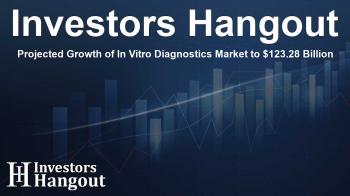Projected Growth of In Vitro Diagnostics Market to $123.28 Billion

Understanding the In Vitro Diagnostics Market Dynamics
The global In Vitro Diagnostics (IVD) market is on a remarkable growth trajectory, expected to reach an impressive $123.28 billion by 2032, growing at a CAGR of 5.5% from 2025. This growth is largely attributed to several key factors impacting healthcare today.
Key Drivers of Market Growth
One of the principal drivers behind this surge is the rising prevalence of chronic diseases worldwide. As more individuals are diagnosed with conditions such as diabetes, cardiovascular diseases, and cancers, the demand for efficient diagnostic solutions grows. Additionally, an increasing number of infectious diseases have highlighted the urgent need for accurate testing, solidifying the position of in vitro diagnostics in the healthcare system.
Furthermore, heightened awareness regarding early disease diagnosis plays a critical role. Patients and healthcare providers recognize that timely detection can significantly influence treatment outcomes and reduce overall healthcare costs, thus encouraging the upsurge in market demand for IVD solutions.
Technological Advancements Fueling Innovation
The IVD sector is experiencing an innovative renaissance driven by technological advancements such as molecular diagnostics and point-of-care solutions. These technologies are not only enhancing the accuracy of test results but also significantly decreasing the time from diagnosis to treatment.
Leading companies are now integrating artificial intelligence into their diagnostic systems, creating a more efficient and intuitive healthcare landscape. With the rise of smartphone-based diagnostic methods, individuals can access important health information directly from their devices, further pushing the IVD market forward.
Segment-wise Analysis of the Market
When examining the market based on offerings, the Kits & Reagents segment is expected to dominate, capturing around 81% of the market share by 2025. Its substantial presence can be credited to the frequent necessity of reagents and kits in numerous diagnostic tests, particularly in the detection of chronic diseases.
The Molecular Diagnostics segment leads in technological advancements, holding approximately 23% of market share, thanks to its exceptional sensitivity in detecting pathogens. This segment is expected to witness the fastest growth due to its essential role in the rise of precision medicine.
Infectious Diseases and Cardiology Applications
Among applications, the segment focusing on Infectious Diseases is particularly notable. It accounts for nearly 37.8% of the market share, thanks to increased testing requirements brought on by global outbreaks. However, the Cardiology segment is poised for remarkable growth, resonating with the increasing focus on cardiovascular health.
Emerging Market Opportunities
The IVD market is not only growing in established regions but also expanding into emerging economies. As healthcare infrastructure improves in these regions, the adoption of personalized medicine is becoming more prevalent, creating significant opportunities for IVD companies.
Strategic partnerships, innovative product development, and a focus on affordable solutions are essential for companies looking to capitalize on these opportunities. The demand for point-of-care testing solutions in remote areas reflects a growing need for accessible healthcare.
Challenges and Future Outlook
Despite the promising growth forecast, the IVD market faces challenges from stringent regulatory frameworks and the technical complexities associated with advanced diagnostic technologies. Companies must navigate these hurdles effectively while still striving for innovation.
With an ongoing commitment to research and development, coupled with investments in technology and strategic market positioning, the IVD market is set to evolve beautifully. Ongoing advancements will ensure that the healthcare landscape continues to transform, fostering better patient outcomes globally.
Frequently Asked Questions
What factors are driving growth in the IVD market?
The growth is driven by rising chronic disease prevalence, demand for early diagnosis, and advancements in technology.
What is the expected market value of IVD by 2032?
The IVD market is projected to reach $123.28 billion by 2032.
How is technology impacting the IVD market?
Technological advancements like molecular diagnostics and AI integration are improving accuracy and efficiency.
Which market segment is expected to grow the fastest?
The Molecular Diagnostics segment and the Cardiology applications are projected to experience the fastest growth.
What challenges does the IVD market face?
Challenges include stringent regulations, technical complexities, and maintaining quality while innovating.
About The Author
Contact Lucas Young privately here. Or send an email with ATTN: Lucas Young as the subject to contact@investorshangout.com.
About Investors Hangout
Investors Hangout is a leading online stock forum for financial discussion and learning, offering a wide range of free tools and resources. It draws in traders of all levels, who exchange market knowledge, investigate trading tactics, and keep an eye on industry developments in real time. Featuring financial articles, stock message boards, quotes, charts, company profiles, and live news updates. Through cooperative learning and a wealth of informational resources, it helps users from novices creating their first portfolios to experts honing their techniques. Join Investors Hangout today: https://investorshangout.com/
The content of this article is based on factual, publicly available information and does not represent legal, financial, or investment advice. Investors Hangout does not offer financial advice, and the author is not a licensed financial advisor. Consult a qualified advisor before making any financial or investment decisions based on this article. This article should not be considered advice to purchase, sell, or hold any securities or other investments. If any of the material provided here is inaccurate, please contact us for corrections.

